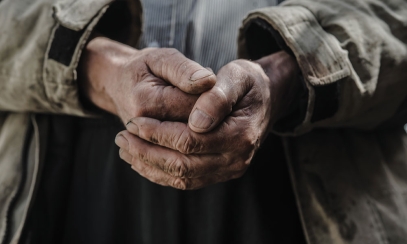
Themes of Catholic Social Teaching
Rights and Responsibilities
Rights and Responsibilities
Human life flourishes when it is in balance. Often, this balance is achieved and maintained only by means of a fragile tension. When this tension is broken or lost, balance is lost and life is overcome by all manner of disorder and even death.
The truth that life is only possible in the tension of balance is something Catholic Social Teaching (CST) articulates well. For example, Catholic tradition teaches that both the protection of human rights and the meeting of responsibilities are required to ensure the dignity of the human person and the health of the community.
Human life flourishes when it is in balance. Often, this balance is achieved and maintained only by means of a fragile tension. When this tension is broken or lost, balance is lost and life is overcome by all manner of disorder and even death.
The truth that life is only possible in the tension of balance is something Catholic Social Teaching (CST) articulates well. For example, Catholic tradition teaches that both the protection of human rights and the meeting of responsibilities are required to ensure the dignity of the human person and the health of the community.
Living in the tension
Numerous popes throughout the ages have referred to the Catholic Church as the Church of the “Great Both … And …” precisely for this reason. This means the Church’s vocation is to deny all that is false and to affirm all that is true – especially when two truths seem to be mutually exclusive.
To illustrate, picture a long suspension bridge. Now, are you able to identify the point of greatest tension?
The point of greatest tension is at the very center of the bridge. The Church invites each of us to also live in and embrace this same tension at the center of the bridge of life. To be sure, it is an arduous challenge, as anyone who has ever stood at the center of a long bridge can testify. In the center, the bridge is not stationary. It moves up and down and sways side to side.
While we sometimes want to cling to certainty, the Church’s teaching grounds us in reality itself. The Catholic faith will not allow us to escape to the safe, secure towers of partial, lopsided truths. Catholicism offers neither a “stuck in the mud” nor a “pie in the sky” spirituality. Instead, it calls us to live in the tension at the center – in other words, to live the life of Christian discipleship which finds its fullest expression at the intersection of the Tree of Life that is the wood of the cross.
The rights of the individual
With this image of the bridge in mind, let’s turn our attention to what CST posits about the rights of each person. Given the fact that the Life and Dignity of the Human Person is the first and foundational theme of CST, it should come as no surprise that CST affirms every person has a fundamental right to life and to those things which are required for human decency.
Beginning with Pope Leo XIII’s Rerum Novarum in 1891, the Church has identified various civil, political, social, cultural, economic and religious rights through the encyclicals that make up the body of CST. For example, Rerum Novarum affirmed the right to private property, a living wage and moral and cultural values. In 1963, St. John XXIII wrote of the right to worship according to one’s conscience and to emigrate and immigrate in Pacem in Terris. Then, St. John Paul II recognized the right to private initiative and ownership in Centesimus Annus. (1991)
With rights come responsibilities
Rights naturally give rise to corresponding responsibilities. For example, the right of an individual to ownership suggests the responsibility of others to recognize and respect this right. This responsibility, of course, extends to the State. The Catechism explains that these rights exist prior to society. (1930) Consequently, society has an obligation to recognize them. Society is ordered to the individual because the person is the ultimate end of society. When a society refuses to recognize the rights of the person, it loses its moral authority and legitimacy. Society becomes disordered and must resort to coercion or violence to enforce obedience.
In this way, rights and responsibilities form an inseparable whole. As St. John XXIII taught in Pacem in Terris, “to claim one’s rights and ignore one’s duties, or only half fulfill them, is like building a house with one hand and tearing it down with the other.” (30)
The Parable of the Good Samaritan makes it clear that respect for the rights of others flows from the call to look upon one’s neighbor as one’s self. In response to a scholar’s question, “Who is my neighbor?” Jesus asks, “Who was neighbor to the robbers’ victim?” (Luke 10: 29-36) Jesus makes it clear that the scholar is asking the wrong question. We are not to busy ourselves with evaluating who qualifies as our neighbor – who is worthy or deserving of rights. Rather, Jesus, as the Catechism suggests, teaches that it is a responsibility, or duty, to make “oneself a neighbor to others and actively serve them” by honoring and defending the fundamental rights of all. (Paragraphy 1932)
Did You Know…
Pope Leo XIV’s choice of name signals his commitment to Catholic Social Teaching. As discussed above, Pope Leo XIII wrote the 1891 encyclical Rerum Novarum.
This encyclical, in essence, initiated what is known as Catholic Social Teaching. Pope Leo XIV has said he hopes to continue addressing social issues such as human dignity and the rights of workers in a manner that is relevant for today.
Who Said That?
“An overemphasis on rights leads to a disregard for duties … The sharing of reciprocal duties is a more powerful incentive to action than the mere assertion of rights.”
A. Pope Leo XIII
B. Pope Francis
C. Pope Benedict XVI
D. Pope John XXIII
Answer: C. Pope Benedict XVI in Caritas in Veritate (43).
Doug Culp is the chief operating officer for the Pontifical Mission Societies of the United States.



